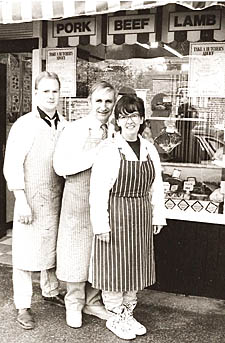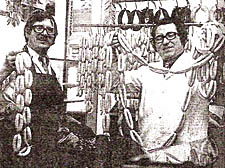
Des Whyman, centre, with son Terry and wife Vicki in 1990

Butchers Paul and Frank Corrigan, 1974. The Corrigan family
ran 12 stores in the borough. |
A butcher's hook at a trade fast dying out
A history of butchers shops makes for a fascinating read, even if the author (butcher, retired) is married to a veggie, writes Dan Carrier
Shoulder of Mutton Field: The Retail Butchers Trade in Camden
by Desmond Whyman, £7.95 order this book
THERE was a silver lining for butcher delivery boy Desmond Whyman.
His Hampstead round, which required him to get his bike from
the foot of Haverstock Hill up to Whitestone Pond and beyond,
meant although it was hard going on his way out, he could freewheel
his way back down.
Then there were the tips he’d get at Christmas and some
of his customers gave him some kudos among his friends. He got
to deliver to forces’ sweetheart and national icon Vera
Lynn at her house next door to the Bull and Bush pub.
Such vignettes are the background to a remarkable book written
by the former Kentish Town butcher. Mr Whyman spent the first
10 years of his retirement researching the Camden meat trade
where he made his livelihood and the result is a read that is
captivating for its detail and is an important social history.
Des, 65, eventually qualified as a butcher himself and ran his
own shop in Queen’s Crescent and then later in Romford.
But his story starts in 1702 when, as Mr Whyman notes, “the
presence of a hawking meat seller was recorded in the parish
registers”.
Mr Whyman says he was compelled to write the history of Camden’s
meat trade because he realised something that was a facet of
every day life was rapidly disappearing.
He says: “In the last 20 years your high street butchers
have been closing at an astonishing rate. It was an important
part of people’s daily shopping routine and provided people
with jobs too.”
His research reveals that at first the local meat trade started
with a person using a smallholding to raise his own pigs. Any
surplus would be pickled and sold to neighbours. This cottage
industry developed in time with the home being converted into
a makeshift shop. In 1788, a Joseph Hale established a butchers
in Angler’s Lane and by 1823 a business directory noted
there were already seven butchers in a small stretch of Kentish
Town running from Angler’s Lane up to the Bull and Gate
pub.
Mr Whyman was born in Rhyl Street, Kentish Town in 1941. He
came from a family of meat sellers – his grandmother was
Hannah Aries, part of the Aries Brothers from Chalk Farm Road,
which Mr Whyman has traced back to 1856 where they ran a beef
and ham shop.
He managed R&C Butchers in Queen’s Crescent before
taking over a shop in Romford.
He says: “I got the idea for the book when I thought about
how the trade had changed since I was a boy.
“There was always a butchers in every street and people
would have their meat delivered to their door. In the past 20
years high street shops have disappeared and I wanted to make
sure the history was not lost forever. I hope in years to come
someone will pick up the book and say: ‘I don’t know
who this Des chap is, but I am pleased he bothered recording
this’.”
Mr Whyman’s own professional background is tied in with
the rise and decline of the butcher: the place he learnt his
trade has long disappeared.
“I did my own training in Harrisons Butchers in Camden
High Street in the 1950s,” he recalls.
He left Haverstock School in 1955 and started work as a delivery
boy for Lidstones, run by an Irish butcher called Mr Gray.
“On my first day I noticed he was missing three fingers
on his left hand he told me he had lost them in the mincing
machine,” he continues. “I suddenly thought to myself
I’m not very keen on becoming a butcher after all. But
I still turned up the following day.
“We started at six every morning. I’d set off on my
deliveries that the butchers had already prepared.”
In his basket were around 25 different cuts – and because
his round took him to the heights of Hampstead, he would deliver
more expensive meat than if he was going to homes in Kentish
Town and Camden Town.
“They would have lots of game – pheasants, snipes,
and they would always ask for steak instead of stewing lamb.”
His deliveries would take him up to lunchtime, and then it was
back to the shop to spend the afternoon cleaning.
He worked every day up to 5.30pm – excluding Sundays and
Thursday, which were traditionally early closing day. He was
paid one pound, 17 shillings and six pence – and was also
allowed to take some mince or sausages home twice a week, and
a joint from the display window on Saturday night for his family’s
Sunday roast.
Mr Whyman spent seven years as an apprentice learning his trade
before running Kimbers Butchers. It was here he met and married
Victoria Saunders, his wife of 42 years.
She lived in nearby Islip Street and would come in with her
mother.
“One day, soon after we had been married, I brought home
a lovely piece of steak,” he recalls.
“She looked at me and said she had a confession to make,
she hated meat and had been a vegetarian all her life. She had
only come in to the shop regularly so she could court me. Imagine
that, a veggie marrying a butcher.”
|



